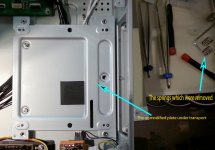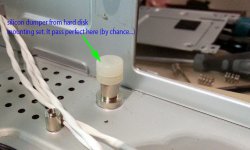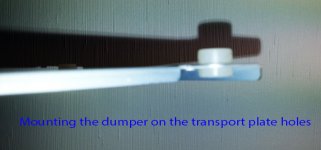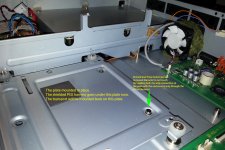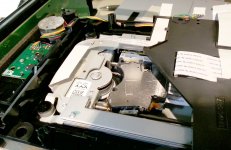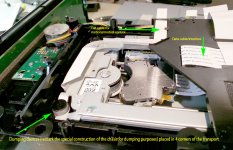John... as in "105 sound so good so I cant hear them" or "I shorted them and I could not hear any difference" ? Sorry, just interested in your evaluation method.
/
/
That's good news 🙂.The output caps on the 105 are pretty good quality and I can't hear them in their circuit.
Eric will
So, I har a resounding - No!
/
you sould look at Test OPPO Muse modifiés par Espace-musical : une meilleure écoute analogique | Haute Définition sur HDfever, in french.
Output cap bypassed by other caps, every thing that is between output cap and cinch bypassed by a low value resistor (like 27ohm), and, If I'm correct, output op-amp biaised into class A (not sure if the connection point is psu or ground).
The reviewer is more than happy with the mod.
best regards
Philippe.
The Oppo output caps are there for a reason. I know the reason, but I cannot reveal it. The usual output stage sounds better than the headphone output stage (that has no caps) into a hi Z load.
The Oppo output caps are there for a reason. I know the reason, but I cannot reveal it. The usual output stage sounds better than the headphone output stage (that has no caps) into a hi Z load.
If you work for Oppo, then of course you can not reveal one or another... but only grab the most of detailed informations from the thread/forum, about others findings...
Anyway, thanks for you let us to know that you know more than us.
You don't have to be rude Coris. The reason is not mine to reveal. It is a 'trivial' reason in any case. I DID compare the main output with caps against the headphone output with identical 50K loading and found that the caps were not a significant factor in the sound quality.
I think is wrong to load the headphone output with 50K. This output is meant to work with quite low impedance/load. That final amp chip is not made to (well) function with so high impedance loads... At last this output has an unacceptable high noise level.
Else the output caps are for sure there to isolate/prevent high DC offset out on the line. For some reasons Oppo can not control (production process) this DC offset of the final opamps, even though it were all right this aspect for 95 model... In my opinion, using such caps can not at all be called an improvement for the 105 model. If this model it happens to sound better than 95 this is because other improvements (better power supply, and some other things), but not because placing those caps on outputs.
Else the output caps are for sure there to isolate/prevent high DC offset out on the line. For some reasons Oppo can not control (production process) this DC offset of the final opamps, even though it were all right this aspect for 95 model... In my opinion, using such caps can not at all be called an improvement for the 105 model. If this model it happens to sound better than 95 this is because other improvements (better power supply, and some other things), but not because placing those caps on outputs.
mvc: you've tried the 105 direct to the amp - no transformer intermediate?
Thankyou.
Yes, I also tried that, balanced and single ended. Obviously it is even better, but not by a large margin. My transformer preamp (S&B TX102 based) is very good. Even direct the balanced output are a bit better than the RCA.
The Oppo output caps are there for a reason. I know the reason, but I cannot reveal it. The usual output stage sounds better than the headphone output stage (that has no caps) into a hi Z load.
Here is how OPPO answered the AC coupling question from dmusoke On the AVS anticipation forum:
"The BDP-105 analog outputs are AC coupled. The BDP-95 used DC coupled output, and we have had a few rare but annoying compatibility issues with certain amplifiers. Some amplifier may have a DC offset on its input and that has caused issues from popping noises, degraded sound to damaged players. We have selected the components carefully so that the AC coupled output can still produce excellent bass response. The capacitors used are high quality ELNA capacitors. Again this increases cost so we do not make this kind of design changes without a good reason. For the unbalanced RCA stereo output, our consultant developed a certain way to bias the components so it actually sounds and measures better than the BDP-95, but requires an AC coupled output."
I can tell you from personal experience that the BDP-103 has a problem with pops and clicks on the variable RCA output when hooked directly to an amplifier. This occurs during pauses in the audio stream and at other times. This prevents the BDP-103 from being used in this mode, and I had to send my unit back.
Now the BDP-105 uses the superior saber chipset, but I think we can assume that OPPO has been very conservative with the BDP-105, including coupling capacitors and muting relays on the outputs.
The good news is that none of us are having problems with pops or clicks on the outputs of the BDP-105.
you sould look at Test OPPO Muse modifiés par Espace-musical : une meilleure écoute analogique | Haute Définition sur HDfever, in french.
Output cap bypassed by other caps, every thing that is between output cap and cinch bypassed by a low value resistor (like 27ohm), and, If I'm correct, output op-amp biaised into class A (not sure if the connection point is psu or ground).
The reviewer is more than happy with the mod.
best regards
Philippe.
Thank you Philippe, I find this review very interesting and inspiring. I particularly like the combination of listening and analytical testing. More details of the modifications would be interesting.
I think the take-home message is that there should be a simple set of improvements that we can make including:
damping sheets on transport housing and chassis
electrical shielding
decoupling capacitors
bypass capacitors on output capacitors.
Perhaps bias or bypass resisters.
Eric
Coris, the sound from the headphone output was the same with either 50K or 30 ohms. I tried both.
I used Sennheiser IE80 - 16ohm, and I was not impressed by the sound... But anyway...
BTW, I use the same headphones with my Note2, and I can say that I`m impressed by the sound... I can even not hear any noises (without signal), as I can hear from the headphone output of Oppo...
The 105 player is a step forward over 95, because some more functions it have, new software functions, and some other improvements. I bought this player not to use it as it is out of the box, but because it have a very big potential when the right mods are in the right place(s)...
I know the theory/explanation of Oppo about this AC coupling. In one way is right how they explain this choice. They have to sell this player to everybody, and have to cover a huge coupling possibilities to the most of the existing amplifiers out there. So, from this point of view they did right with AC coupling. Is the most safe solution to prevent problems for customers. But please, technically point of view, this AC coupling choice is not possible to be named as an improvements...
I also agree that 105 so as it is out of the box it sounds better than 95 in the same condition. This is definitely not because the AC coupling. In the same time I know that an modded 95 it sounds much, much better, and that because I have the trust that an right modded 105 with its newer/improved hardware, will sounds even better...
This is actually the meaning of this thread, dedicated to the improvements one may bring to this player model, to get the best out of it.
BTW, I use the same headphones with my Note2, and I can say that I`m impressed by the sound... I can even not hear any noises (without signal), as I can hear from the headphone output of Oppo...
The 105 player is a step forward over 95, because some more functions it have, new software functions, and some other improvements. I bought this player not to use it as it is out of the box, but because it have a very big potential when the right mods are in the right place(s)...
I know the theory/explanation of Oppo about this AC coupling. In one way is right how they explain this choice. They have to sell this player to everybody, and have to cover a huge coupling possibilities to the most of the existing amplifiers out there. So, from this point of view they did right with AC coupling. Is the most safe solution to prevent problems for customers. But please, technically point of view, this AC coupling choice is not possible to be named as an improvements...
I also agree that 105 so as it is out of the box it sounds better than 95 in the same condition. This is definitely not because the AC coupling. In the same time I know that an modded 95 it sounds much, much better, and that because I have the trust that an right modded 105 with its newer/improved hardware, will sounds even better...
This is actually the meaning of this thread, dedicated to the improvements one may bring to this player model, to get the best out of it.
Last edited:
Has anyone tried to put a 75 Ohm terminator in the coaxial digital output? I happened to have one and tried it. Seems to make a difference. Makes sense, in a way, as it is located right under the stereo output stages.
I think the 75 ohm terminator should be placed on the other end of the coax, but not on the player digital output. But maybe on the other end (digital input) it is already an such terminator (75 ohm resistor)...
A right placed terminator is healthy for a digital line transmission. In my case, I do not use that way...
A right placed terminator is healthy for a digital line transmission. In my case, I do not use that way...
I'm not using a digital input anywhere: I'm using the analoge stereo outputs of the Oppo. I just thought terminating the digital output could prevent reflections. Perhaps there are better ways to do this than with a 75 ohm resistor. Perhaps it isn't necessary at all. I think I hear a small improvement, not much, but then a resistor is extremely cheap.
I have also found that ripping a CD, putting it on a USB drive, plugging that into the Oppo and then playing it from there sounds better than the same CD played in the Oppo's transport. Quite a bit better, actually. Why would that be, and does that mean that the sound quality from the transport could be improved?
Yes, I observe this as well. It is a strong effect, and is presumably due to the deleterious effect of running the transport. A lot of vibration is generated, noise is injected into the power supplies, and EMI may also be generated. There may also be a difference in jitter. This suggests that attacking these problems should improve the sound quality from CD and SACD playback.I have also found that ripping a CD, putting it on a USB drive, plugging that into the Oppo and then playing it from there sounds better than the same CD played in the Oppo's transport. Quite a bit better, actually. Why would that be, and does that mean that the sound quality from the transport could be improved?
Perhaps it is time to start moving some of our collections to hard disk. Certainly the new high-resolution downloads will end up there already.
Coris,I used Sennheiser IE80 - 16ohm, and I was not impressed by the sound... But anyway...
.
I think you might be using the wrong headphones. I'm using the Sennheiser HD-650.
Last night I was listening to the 96kHz - 24bit version of Anne Akiko Meyers - Air: The Bach Album from HD tracks. The sound was very beautiful. It is a wonderful recital.
Eric
I do not affirm that IE80 are the best headphones. This field about headphones is quite marginal for me. I do not prefer to use headphones anyway. Only when I have to. Else it may be something wrong with only my device, about that high floor noise level on headphones output...
Talking about vibrations in the transport mechanism, I think to show here some pictures about a mod in this respect. I done it for 95 quite a time ago, but it apply very well now for 105 too.
As it is mounted this transport in Oppo players (and maybe in another ones too), it not may prevent vibrations to be transmitted to the optical head. As one can see in those pictures here, the manufacturer of the transport has already did quite much to damp the vibrations inside the mechanism. My opinion is that is not enough this.
Oppo use some springs when mounting this device in to the chassis, but the way those are used is very wrong. The plate is pressed on those springs (the pressure is very high), by some bolts, and this is a very rigid construction! The springs, the chassis and the transport should have separate mounting systems, hanging only on those springs, to allow an elastic coupling. Is not the case with Oppo players!
This mod is not very easy to be done, but I present here the pictures as an inspiration to those who want to try it. The first operation here is to eject the tray (when the player is powered), then remove the front panel of the tray (very difficult), then get the tray in again, and then start the rest of the mechanical operations. The first operation in this order is to remove the heavy front panel of the player. This is not very difficult. Then release very carefully the transport bolts, in a progressive way for all of it. The transport have to be protected against mechanical tensions, as the springs are very powerful.
In my case, I forgot to remove that front panel of the tray, when the player it were possible to be powered. It were quite a pain to have the heavy players front panel hanging all the time on that transport tray, under the whole operation... But it were fine at the end...
So be careful with the right order of the operations to be done, to get the transport out of the case...
Then the rest is to be seen in the pictures here....
Talking about vibrations in the transport mechanism, I think to show here some pictures about a mod in this respect. I done it for 95 quite a time ago, but it apply very well now for 105 too.
As it is mounted this transport in Oppo players (and maybe in another ones too), it not may prevent vibrations to be transmitted to the optical head. As one can see in those pictures here, the manufacturer of the transport has already did quite much to damp the vibrations inside the mechanism. My opinion is that is not enough this.
Oppo use some springs when mounting this device in to the chassis, but the way those are used is very wrong. The plate is pressed on those springs (the pressure is very high), by some bolts, and this is a very rigid construction! The springs, the chassis and the transport should have separate mounting systems, hanging only on those springs, to allow an elastic coupling. Is not the case with Oppo players!
This mod is not very easy to be done, but I present here the pictures as an inspiration to those who want to try it. The first operation here is to eject the tray (when the player is powered), then remove the front panel of the tray (very difficult), then get the tray in again, and then start the rest of the mechanical operations. The first operation in this order is to remove the heavy front panel of the player. This is not very difficult. Then release very carefully the transport bolts, in a progressive way for all of it. The transport have to be protected against mechanical tensions, as the springs are very powerful.
In my case, I forgot to remove that front panel of the tray, when the player it were possible to be powered. It were quite a pain to have the heavy players front panel hanging all the time on that transport tray, under the whole operation... But it were fine at the end...
So be careful with the right order of the operations to be done, to get the transport out of the case...
Then the rest is to be seen in the pictures here....
Attachments
Last edited:
- Home
- Source & Line
- Digital Source
- Oppo's BDP105 - discussions, upgrading, mods...
